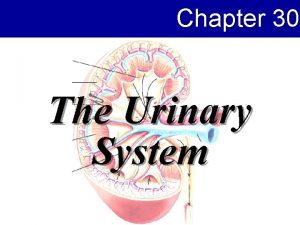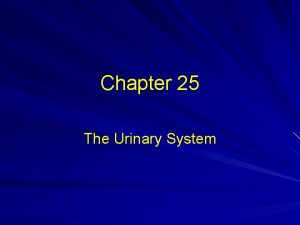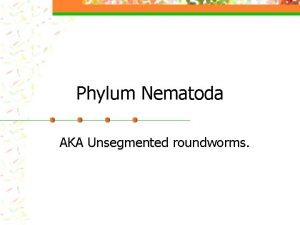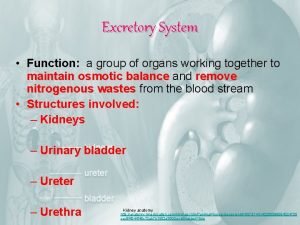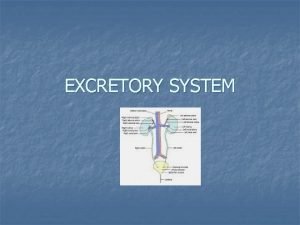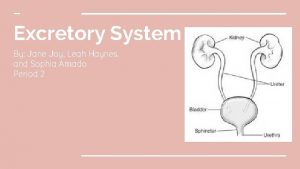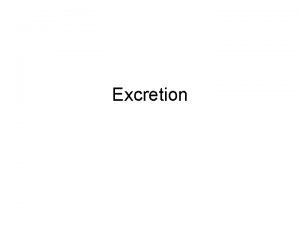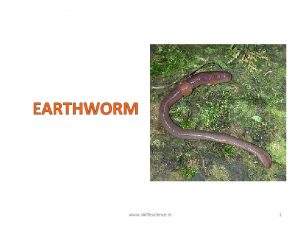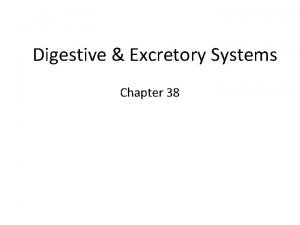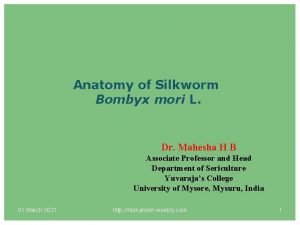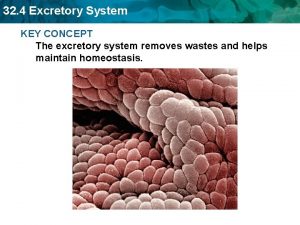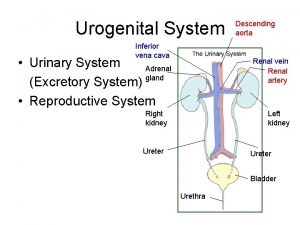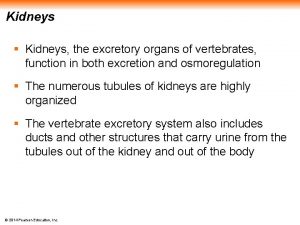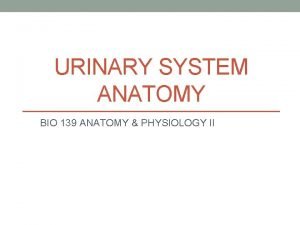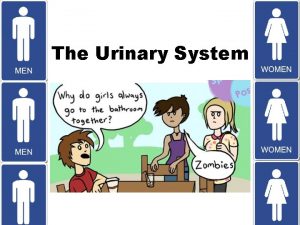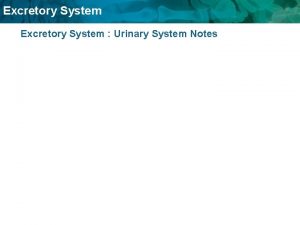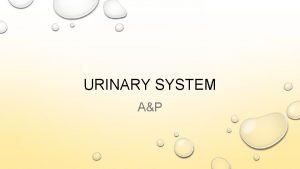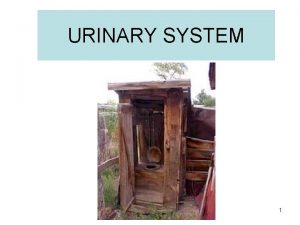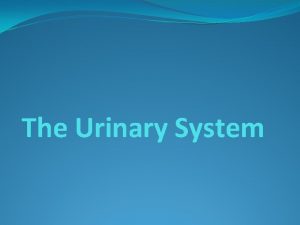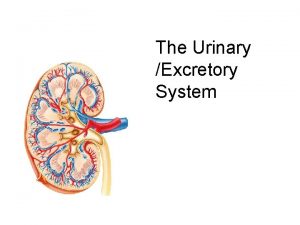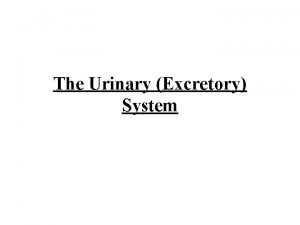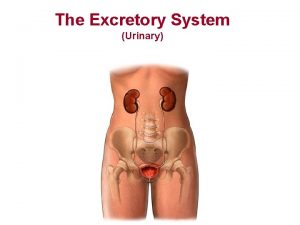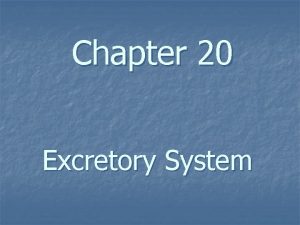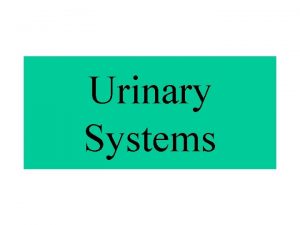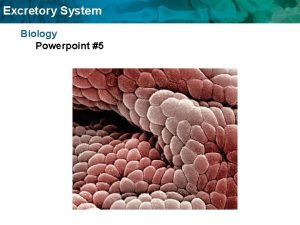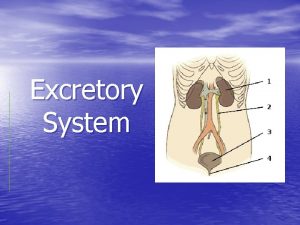Chapter 30 The Urinary System Chapter 30 Excretory

































- Slides: 33

Chapter 30 The Urinary System

Chapter 30 Excretory The Simple System of a Flatworm Excretory Nucleus Pores Flame Cell Cilia Pharynx Excretory Tubule 2

Excretory System of the Earthworm Chapter 30 Nephridia Coelom Nephrostome Excretory Intestine Pore Ventral Nerve Cord 3

Formation & of Urea Chapter 30 Excretion 2 In. Incells, liver, ammonia 13 In amino kidneys, acids are metabolized, isurea combined +Carried water with + in blood releasing ammonia. CO to make other wastes = 22 In liver, ammonia is urea. urine. combined with CO to make 1 In cells, amino acids are metabolized, releasing ammonia. Ammonia NH 33 2 urea Ammonia NH 2 NH -C-NH 2 3 urea. NH 22 -C-NH 22 Carried || O in blood || O excreted 3 In kidneys, urea + water + other wastes = urine. in excreted urine in urine 4

The Path of wastes The human kidneys are paired, bean through the system Chapter 30 shaped organs located on either side of the spinal column extending slightly above the waist. Each is 5 inches long and 3 inches wide, 1 inch thick. Blood carrying dissolved waste enters each kidney through the renal artery. After the blood is filtered, it exits through the renal vein. Urine leaves the kidney via the 5

Renal Artery Kidney Renal Vein Vena Cava Aorta Ureter Urinary Bladder Chapter 30 6 The Human Urinary System

Chapter 30 Ureter- uses peristaltic contractions to transport urine to the urinary bladder ( the bladder) Bladder- a hollow, muscular chamber that collects and stores urine. The walls of the bladder contain expandable smooth muscle. Urine is kept in the bladder by 2 sphincter muscles located at the base above the junction of the urethra. When the bladder fills, receptors on the walls signal the condition and triggers reflex contractions. 7

Chapter 30 Bladder (cont’d) Internal sphincter – sphincter closest to the bladder opens during this reflex. External sphincter – lower sphincter is under voluntary control so the brain can suppress the reflex unless the bladder distension becomes acute. An average adult bladder can hold 500 m. L of urine but the need to urinate is triggered by smaller amounts. Urine makes its way out via the urethra. It is 1. 5 inches in females and 8 inches 8

Storage and Urine Ureter Bladder Urethra Chapter Excretion of 30 9

Chapter 30 Ureter Urinary Bladder Urethra (in penis) 10 The Human Urinary System

Chapter 30 11 Formation Urine is formed in the kidneys. Each kidney has a solid outer layer where urine is made. There is also a subdivided inner chamber called the Renal pelvis – collects urine and funnels it to the ureter. The outer layer of the kidney includes the renal cortex overlying the renal medulla. This outer layer has an array of tiny filters called nephrons, which is

Renal Pelvis Renal Cortex Nephron Renal Medulla Renal Pelvis Chapter 30 12 Cross Sectio Renal Artery n of a Kidne y Renal Vein Ureter

Chapter 30 13 Kidney Function Summary Waste removal • Filtration by the glomerulus • Urine formation in the nephron – Tubular reabsorption – Tubular secretion • Production and concentration of urine Maintenance of homeostasis • Regulation of water content in the blood • Regulation of levels of molecules in the blood • Maintenance of blood p. H • Regulation of blood pressure and oxygen

Chapter 30 The Nephron 14 The glomerulus – a dense knot of capillaries from which the fluid from the blood is collected. Bowman’s capsule – a surrounding cuplike structure. Tubule – a long twisted tube divided into: i. Proximal tubule ii. Loop of Henle – extends into the renal medulla iii. Distal convoluted tubule – leads into

Collecting Duct Distal Tubule Proximal Tubule Bowman’s Capsule Arterioles Branches of Renal Artery Renal Vein Loop of Henle Capillaries Chapter 30 15 An Individu al Nephro n and Its Blood Supply

What does the filter? Chapter 30 kidney 2 million nephrons Filter 180 litres/day All but 1. 5 litres is reabsorbed Minimum output of urine is 300400 m. L/day 16

Chapter 30 Material Filtered in 24 Hrs Substance filtered Amount reabsorbed Glucose 1. 8 Kg 100% Na+ 99. 4% - Cl HCO 3 99. 2% - 99. 9% 17

Kidney function-waste Chapter 30 removal 18 a. Filtration by the glomerulus • Water, nutrients and wastes are forced into fluid in Bowman’s capsule by pressure in the capillaries of the glomerulus

Urine Formation in Nephron 1 Filtration Loop of Henle 2 Tubular Reabsorption Chapter 30 the 3 Tubular Secretion 4 Concentration 19

Chapter 30 20 b. Urine formation in the nephron 1) Tubular reabsorption in the proximal tubule, most nutrients and water are reabsorbed into the blood 2) Tubular secretion in the distal tubule additional wastes (H, K, NH 3) and drugs are actively secreted into the tubule from the blood

Chapter 30 21 c. Production and concentration of urine in the collecting duct additional water may be secreted back into the blood, making the urine more concentrated and the blood less concentrated the loop of Henle creates a concentration gradient through which the collecting duct passes as the filtrate (urine) passes through the collecting duct it becomes the same concentration as the surrounding

Chapter 30 22

Chapter 30 23

Related topics to system A. Hypertension B. Urine testing C. University life and "hyperdiuresis" D. Dialysis and kidney transplantation Chapter 30 urinary 24

Chapter Function-maintenance of 30 homeostasis 25 a. Regulation of water content in the blood In the case of dehydration, sensors in the brain stimulate the release of the hormone ADH (antidiuretic hormone also called vasopressin) ADH is released from the pituitary It passes through the blood to the kidneys where it stimulates the release of water back into the blood from the distal tubule and the collecting duct. When water balance is normal, the ADH

Chapter 30 26

Chapter 30 Homeostasis in excretory system http: //www. youtube. com/watch? v=Wtr Yotj. Yvt. U http: //www. youtube. com/watch? v=PQR t. RA_R 1 ic http: //www. youtube. com/watch? v=RO HOn. PUu 0 a. A 27

Chapter 30 28 b. Regulation of levels of molecules in the blood Penicillin, salicylates (aspirin) excreted glucose, proteins, and amino acids are all reabsorbed. phosphate, sulfate, lactate, vit. C all reabsorbed.

Chapter 30 c. Maintenance of blood p. H Most important buffer system is bicarbonate ion (HCO 3 - ) buffers maintain constant p. H kidney reabsorbs bicarbonate when blood is acidic and produces bicarbonate to further buffer the blood. 29

Chapter 30 30 d. Regulation of blood pressure and oxygen content when blood pressure falls, kidneys release renin into the blood. This causes formation of angiotensin causes arterioles to constrict increasing blood pressure. Constriction also causes less blood to be filtered, maintaining water balance and further increasing blood pressure. for low oxygen levels, kidneys release erythropoietin, stimulating red blood

Renal Pelvis Renal Cortex Nephron Renal Medulla Renal Pelvis Chapter 30 31 Cross Sectio Renal Artery n of a Kidne y Renal Vein Ureter

Regulation of Sensors in Water in Blood hypothalamus gauge osmotic concentration Deviations cause posterior pituitary to turn ADH release on or off ADH restores blood osmotic concentration • Red = increased osmotic concentration • Green = decreased Chapter 30 1 5 2 3 4 32

Chapter 30 The End
 Chapter 20 urinary/excretory system
Chapter 20 urinary/excretory system Lymph tissue fluid
Lymph tissue fluid Figure 15-3 the urinary system
Figure 15-3 the urinary system Chapter 11 urinary system medical terminology
Chapter 11 urinary system medical terminology The urinary system chapter 30
The urinary system chapter 30 Chapter 15 the urinary system figure 15-3
Chapter 15 the urinary system figure 15-3 The urinary system chapter 15
The urinary system chapter 15 Chapter 9 the urinary system labeling exercises
Chapter 9 the urinary system labeling exercises The urinary system consists of
The urinary system consists of Physiology of urine formation
Physiology of urine formation Excretory organs in mammals
Excretory organs in mammals Excretory system of phylum nematoda
Excretory system of phylum nematoda Intugementary
Intugementary What does the excretory system do
What does the excretory system do What is the function of the excretory system
What is the function of the excretory system Excretory organs
Excretory organs 5 facts about the excretory system
5 facts about the excretory system Major functions of the excretory system
Major functions of the excretory system Section 38-3 the excretory system
Section 38-3 the excretory system Peristomium in earthworm
Peristomium in earthworm Questions on digestive system
Questions on digestive system Fetal pig diagram labeled answers
Fetal pig diagram labeled answers 5 facts about the excretory system
5 facts about the excretory system Birds classification
Birds classification Vertical
Vertical Excretory system
Excretory system Respiratory system quizizz
Respiratory system quizizz Vena cava excretory system
Vena cava excretory system Excretory system of vertebrates
Excretory system of vertebrates Excretory system song
Excretory system song Section 38-3 the excretory system
Section 38-3 the excretory system Urinary system model
Urinary system model Urinary system model
Urinary system model Excretory system
Excretory system




